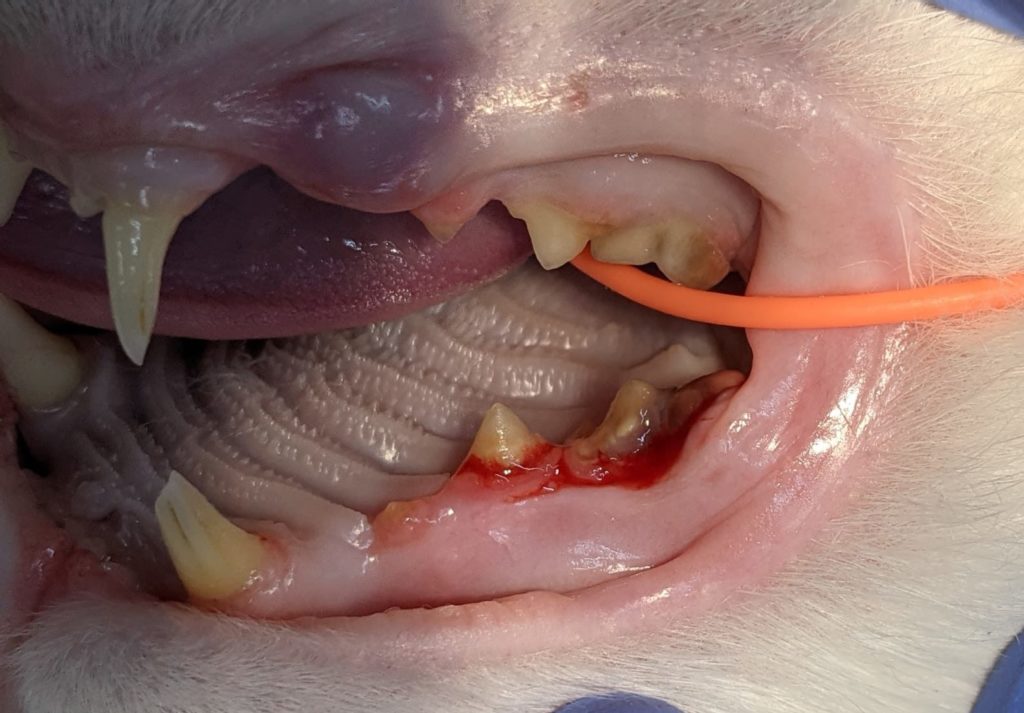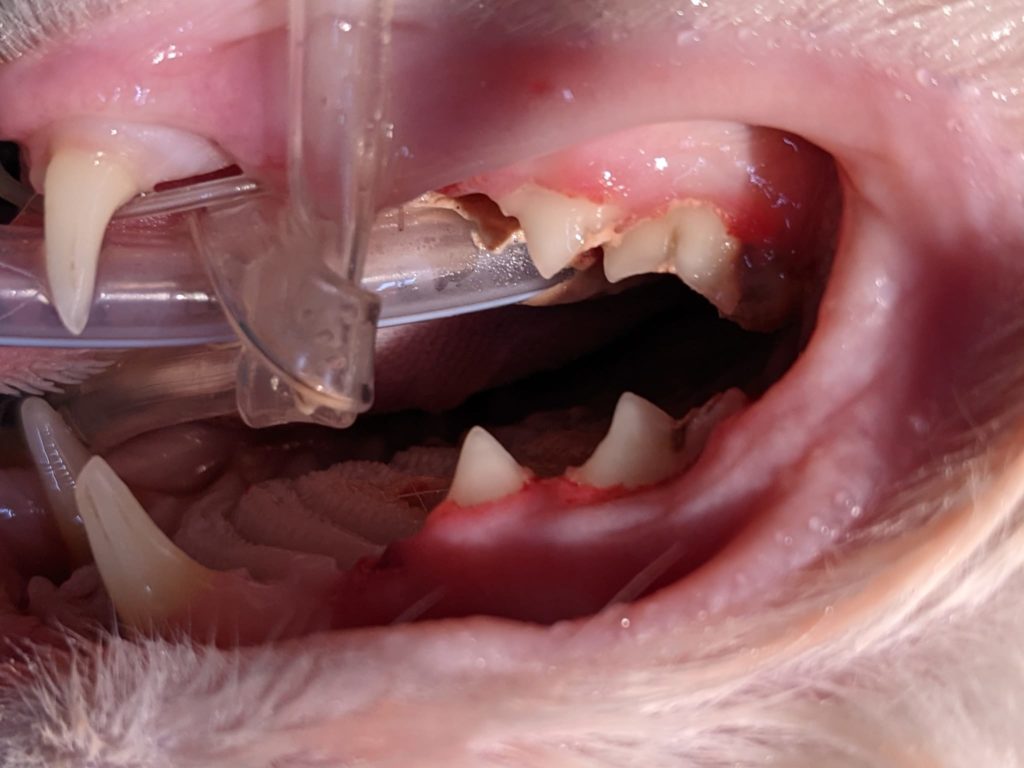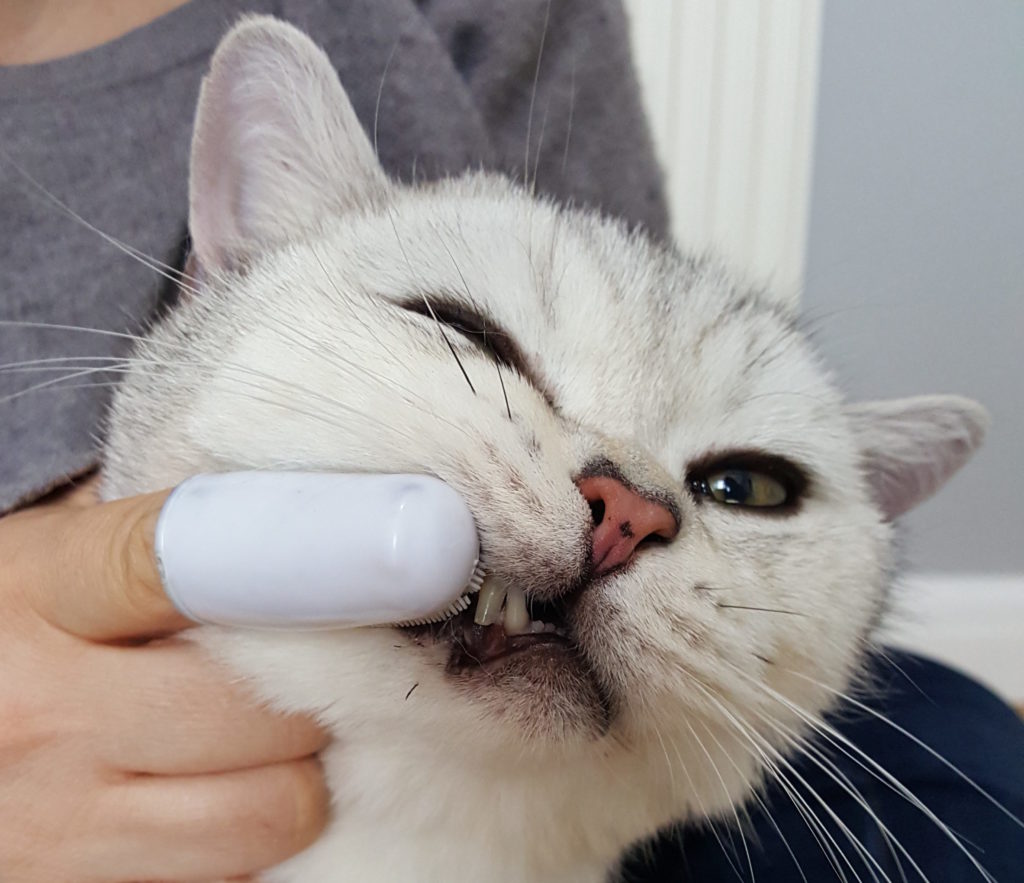We all want to help our cats stay as healthy and comfortable as possible, and that includes looking after their teeth. Some cats are just lucky – they are genetically programmed to have good teeth and that is that. But most will develop dental disease at some point in their lives, especially as they get older, and I would say that dental disease is one of the biggest causes of discomfort we see in our senior feline patients. Not all dental disease can be prevented, but some can, so it’s worth putting some effort into helping your cat maintain good dental health, especially while they are younger. So how do we actually go about providing dental care?
Let’s start by making one thing clear – the average dry food does NOT clean your cat’s teeth. Contrary to what many educated and well-meaning individuals may have said in the past, the average dry cat food probably does not clean your cat’s teeth any more than a carrot cleans yours. A lot of the time, dry biscuits aren’t even chewed, they are swallowed whole, so even if standard dry kibble did have some benefit for the teeth, it is pretty minimal. As obligate carnivores, cats’ teeth are sharp and pointy, perfectly built for ripping meat off bones, not chewing biscuits – feeding cats standard dry food to help their teeth therefore just doesn’t make much sense. So feed your cat a proper, high meat diet which promotes overall good health, and deal with their teeth separately.
The average dry food does NOT clean your cat’s teeth.
What CAN we do to keep our cat’s teeth healthy then?
Your cat’s vet is also their dentist, so your vet and vet nurse are the best people to advise on dental care (and to be honest, your vet nurse is probably far more helpful when it comes to preventative care!). We’ll talk about home care in a minute, but first, here is how your vet practice can help:
Regular dental checks
I cannot stress this one enough, because unless we’re looking, we’ll never know if your cat’s teeth are healthy or not. Cats usually won’t come up to you and tell you that their mouth hurts, and chances are it won’t affect their ability to eat. We humans can get away with not eating when we have a toothache because we know the dentist will sort it out in the morning – a cat’s natural instinct with all pain including dental pain is to just accept it and move on.
- Try to take a look at your cat’s teeth every once in a while by just lifting their upper lip. You don’t have to open the mouth fully, especially if there is any chance you might get bitten, as most tartar forms on the outside surface of the teeth. The more you do it, the more they will learn to tolerate it and the better you’ll get at seeing any problems if they do occur. If you have any concerns, let your vet know.
- In addition to your own checks, during your cat’s routine annual health check your vet will examine the mouth and teeth, giving them a chance to detect dental disease early and treat as necessary. If your vet thinks your cat would benefit from a dental cleaning, they will probably let you know but please ask if they don’t mention it either way.
Dental cleanings
A short and generally painless procedure, just as your own teeth are cleaned by the hygienist, except performed under general anaesthesia (because let’s face it, when was the last time your cat opened his mouth on command?). Good home care will help keep your cat’s teeth cleaner and if your cat has been blessed with good dental genes, they may never even need a professional cleaning. Most cats, however, will require a dental procedure at least once and some may need several over their lifetime. The jury is still out as to whether or not routine cleanings (ie to PREVENT significant tartar buildup as opposed to removing tartar that has already built up to a harmful degree) are beneficial to cats, so until I hear convincing evidence otherwise, I will only recommend this procedure if I feel it will increase the quality of your cat’s life by reducing the discomfort of existing disease.


- If done regularly and in good time, this is a relatively straightforward procedure. If delayed, there is a higher chance of your cat developing irreversible disease that requires extraction of the affected teeth. This not only increases the length and cost of the procedure, but also results in more discomfort for the cat. If your vet discovers diseased teeth that need to be extracted during a routine dental cleaning, please allow this – leaving damaged teeth in the mouth is far more painful than taking them out.
- Age is not generally a good reason to avoid a dental procedure (though any anaesthetic procedure does involve some risk), as dental disease itself can have harmful effects on the rest of the body including the kidneys and heart which can affect their overall health and comfort levels. In fact, many owners of older cats who have had dental treatment remark that the procedure has brought them back to the cat they were several years ago. If you have concerns about putting your older cat under anaesthesia, a full physical exam and blood test should be done before the procedure to ensure that they are fit enough for the anaesthetic.
Age is not generally a good reason to avoid a dental procedure
Caring for Your Cat’s Teeth at Home
What is the best way to prevent dental disease in cats? The best answer is probably whatever your cat will tolerate. There is unfortunately no one magic solution that works for all cats all the time but here is a list of things that you might like to try:
- Brushing their teeth daily – Ok, sticking your fingers in your cat’s mouth is probably not your (or their) idea of a good time! This probably isn’t going to be a realistic option for most adult cats so don’t feel bad if it isn’t a sensible option for you. However, we cannot ignore the fact that the abrasive action of a toothbrush and toothpaste is the best way to remove dental plaque. If you have a confident cat who doesn’t mind you touching his mouth, or a younger cat who is happy to accept new routines, it’s worth a go. For more information, take a look at our article on Brushing Your Cat’s Teeth.
- Dental diets and treats – the exception to the ‘dry food doesn’t really help your cat’s teeth’ rule, these special diets are designed not to break until they reach the gum line, thus providing mechanical cleaning action as your cat eats. I usually recommend that these diets be used as a supplement or treat alongside your cat’s current diet, not fed as the main diet, as they are high in fat and at the end of the day they are still a dry food and this can cause cats any number of other problems.
- Raw chicken wings – yes, you read that correctly, raw chicken wings. Never cooked, as this can result in the bones splintering into dangerous sharp pieces, but cats have been eating raw meat and bones for as long as cats have roamed the earth; think of it as nature’s toothbrush. Any food carries some risk and raw chicken wings are no exception, however complications are uncommon and the potential benefits are significant. Make sure the meat is fresh (or previously frozen to kill most of any bacteria/parasites that may be present and then safely thawed) and that you trust the source. In the wild, cats eat their prey right after they kill it, so meat that has sat around for too long isn’t safe or appropriate for them. Also, be sure to offer it in an area that is easy to clean and disinfect after they have. It’s not for every cat (or every owner!) and their tummies may require a bit of a transition period as it is very different from dry food, but for those that do accept it not only is it good for the teeth, it also acts as an excellent protein source and gives them something fun to do too by allowing them to fulfil one of their natural instincts.
- PlaqueOff – This is an interesting product that contains seaweed, which claims to reduce the buildup of tartar. Forever the skeptic, I have actually seen this product work, so I’ll include it on this list. It is very important to note however that as seaweed contains high levels of iodine, do NOT give PlaqueOff to cats with hyperthyroidism or who may be at risk of becoming hyperthyroid based on previous blood results.
- Water additives – Some of these are rubbish, while some have clinical trials to try to prove that they are not. There are some products out there that look promising, but like anything else, do your research and make sure you trust their claims. Also, be very careful what you put into your cat’s water, as not all products that are safe for dogs are safe for cats (xylitol, for example, is a common additive and in large quantities, can be toxic to cats).
- Oral hygiene gels – eyzmatic gels/cat toothpastes are useful products that you can smear on the outer surfaces of the teeth using just your finger. It helps the body’s natural defences fight harmful bacteria in the mouth and contains mild abrasives which help break down plaque. This isn’t going to be as effective as brushing, but could be beneficial in cases where brushing just isn’t possible. Despite what the manufacturer may say, it seems highly unlikely that cats would receive much benefit from these products just by licking them off their paws so I probably wouldn’t bother if that was your only option.
When considering any of the above products, foods and treats, aim for those with VOHC (Veterinary Oral Health Council) or other veterinary dental group approval. These products have undergone further testing to show that they are both safe and effective, so a good place to start.
In conclusion…
For the best chance of success, be sensible and tailor your cat’s dental care to their attitude towards human interference. If you have a scaredy cat who won’t even let you pick them up, please, please don’t try to brush their teeth, it will only end in more anxiety on everyone’s part. Less hands-on methods such as a few dental biscuits or PlaqueOff are likely to be far more appropriate for your cat. If, however, you have a confident cat who likes the attention and doesn’t mind a bit of fuss, by all means, give tooth brushing a go. Not sure? Give everything a go and see what works. And remember – if, despite your best efforts, your cat does develop dental disease, please follow your vet’s advice and get it treated sooner rather than later to avoid a lot of unnecessary suffering later in life.
Resources
- International Cat Care (https://icatcare.org/advice/how-to-brush-your-cats-teeth/) — another take on home care and brushing your cat’s teeth
- Cats Protection (https://www.cats.org.uk/help-and-advice/health/dental-care) — a good summary with videos on feline dental care


